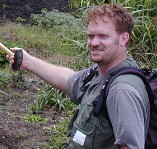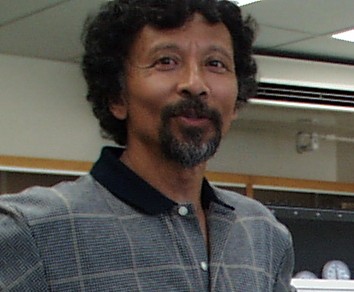Laser Ablation ICP-MS
Analysis at Oregon State University
General Information
Through
the W.M. Keck Collaboratory
for Plasma Spectrometry in the College of Oceanographic and Atmospheric
Sciences (COAS) Oregon State University possesses world-class facilities for
making Laser Ablation ICP-MS (LA-ICP-MS) measurements of a range of solid
materials. These facilities may be used by internal or external users. The major
users of the facility thus far are geologists and geochemists, interested in the
chemical compositions of rocks, glasses and minerals, and fisheries biologists
using otoliths to study fish life histories. However we have also used the
equipment to study a wide range of other solid materials, including gels,
plastics, alloys and more and would be happy to work with you to see if we can
help you with your solids analysis needs.
Equipment
Since
July 2011 we have been operating a Photon Machines G2 short pulse
length ArF Excimer laser, equipped with two
volume ablation cell. This laser is a substantial improvement over older
facilities. The two volume cell can hold 9 x 1" round sample mounts or 3 x 1"
round + 4 thin sections. The two volume cell also provides considerably better
performance in terms of washout time, response, sensitivity and elemental
fractionation. The larger sample cell also results in better sample throughput.
There is also an improved range of spot sizes and shapes, including adjustable
slits for sampling complex materials.
For mass
analyzers we have a choice of two different ICP-MS systems:
Thermo Xseries2
quadrupole ICP-MS (web
camera). Newly installed (July 2011) this instrument is dedicated
almost exclusively to laser ablation. The combination of new laser and
quadrupole system has lead to an improvement in sensitivty of 20-50 x for most
trace elements Some of the common uses are:
-
Analysis
of lithophile trace elements (incl. Sc, V, Cr, Ni, Rb, Sr, Zr, Nb, Y, Ba, REE,
Ta, Hf, Pb, U, Th etc.) in silicate minerals, melt inclusions and glasses.
-
Measuring
Sr/Ca ratios and trace element (Ba, Mg, Mn, Pb, Cu, Zn etc.) fish otoliths and
scales.
-
Elemental
analysis of gels, plastics, alloys and other artificial materials
-
Analysis
of archeological materials
NuPlasma Multicollector ICP-MS. (WeB
camera) This machine,
installed in the Keck Collaboratory in mid 2003, is well suited to the
measurement of isotope ratios via laser ablation. Using the new G2 laser system
we are now routinely measuring Sr isotope signatures in otoliths and also
working on Sr and Pb isotope techniques for geological materials.
Sample Preparation Guidelines:
Sample
preparation requirements for Laser Ablation can be fairly minimal, and if
required we can ablate non-polished surfaces and analyze vacuum-sensitive
materials. The only real limit is the size of object that can fit in the
ablation chamber. However, for the best possible results it is often
still best to conduct analyses on flat polished surfaces, which simplifies the
interaction of the laser with the surface and makes it easier to document the
exact location of each analysis point by reference to photomicrographs. Further,
because LA-ICP-MS data is most commonly reduced by reference to an internal
standard element that has an independently-known concentration (typically Si,
Ca, Ti, Mg etc...), it may be best to prepare your sample so it can also be
analyzed by electron microprobe in addition to laser ablation.
In
general the sample chamber can fit two types of prepared sample materials:
-
Material
mounted on American-size 2" x 1" (50 x 25 mm) petrographic thin sections. These
should, if at all possible, be polished and above all should not
have a cover slip. The overall thickness of material on top of the section can
be up to ~1 mm. If you are preparing polished thin sections specifically for laser ablation
analysis of rocks or other solids I would recommend making them ~ 100 microns
thick to allow for extra ablation depth (although we can also analyze standard
30 micron thin sections if need be). Note that European-size 50 x 25 mm thin
sections are slightly too large for the sample holder and need to be ground down
(we can do this on site).
-
25 mm
diameter circular plugs similar to those commonly used for electron and ion
microprobes. These can be up to ~15 mm thick. The mounting media can be any of
the commonly used mounting materials - I generally use epoxy.
Sample Documentation
I cannot
overstress the importance of good sample documentation. It is the solution to
efficient use of machine time (less time spent finding out where you are on your
sample = more time using the machine for analysis). The optics of the viewing
system for the laser are good, but not great, and a good-quality photomosaic map
of the sample surface taken in reflected light is your key to efficiently
locating sample analysis points. For locations where point location is critical
(e.g. small mineral inclusions or defects) a larger scale photo is also
worthwhile. The laser optical system also has transmitted light, but not with
crossed polarizers.
If you
are visiting OSU to to laser ablation work you can bring the photos with you or
use the facilities in the Department of Geosciences to make them after you
arrive - but give yourself enough time to do this (at least an hour per sample
map).
Fee
Schedule
Fees for
the use of the laser ablation system (for ExCell, Axiom or NuPlasma mass
analyzers) are:
Academic
user $60-80/hour
Commercial user $100/hour
Schedule analysis time
To
discuss your analysis needs or schedule analysis time please contact:
|
Adam Kent (Laser ablation
applications)
College of Earth, Ocean and
Atmospheric Sciences
104 Wilkinson Hall

Oregon State University
Corvallis, OR 97330-5503
Phone: 1-541-737-1205
Fax: 1-541-737-1200
Email:
adam.kent-geo.oregonstate.edu |
Andy Ungerer
(Collaboratory Manager)
College of Earth, Ocean and Atmospheric
Sciences
104 Ocean Admin Bldg

Oregon State University
Corvallis, OR 97331-5503
Phone: 541 737-5225
Fax: 541
737-2064
Email:
aungerer-coas.oregonstate.edu |